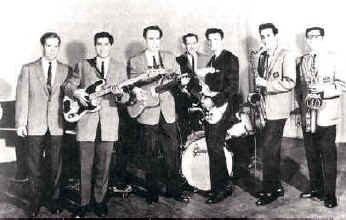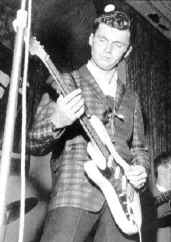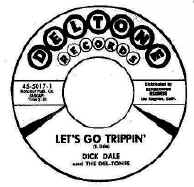Dick Dale and the Del-Tones

Dick Dale and Del-Tones circa 1961-1962
(L to R) Bill Barber, Rick Rillera,, Nick O'Malley, Jerry
Stevens,, Dick Dale, Armon Frank, Barry Billera
Dale's 1961 West Coast hit, "Let's Go
Trippin,'" released two months before the Beach Boys'
"Surfin," is considered the beginning of the Sixties
surf music craze.
Members of Dick Dale and the Del-Tones: :
Dick Dale (real name Richard Monsour) - lead
guitar
Armon Frank - saxophone
Billy Barber - piano
Rick Rillera - bass guitar
Nick O'Malley - guitar
Jerry Stevens - drums
Barry Rillera - saxophone/guitar
Dick Dale invented surf music in the 1950's not the '60's as is
commonly believed. He was given the title "King of the Surf
Guitar" by his fellow surfers whom he surfed with from
sun-up to sun-down. He met Leo Fender the guitar and amplifier
Guru and Leo asked Dale to play his new creation, the Fender
Stratocaster Electric Guitar. The minute Dale picked up the
guitar, Leo Fender broke into uncontrolled laughter and
disbelief, as he watched Dale play a right handed guitar upside
down and backwards. Dale was playing a right handed guitar
left handed and changing the chords in his head then transposing
the chords to his hands to create a sound never heard before.
Fender gave the Stratocaster along with a Fender Amp to Dale and
tell him what he thought of it. Dale took the guitar and started
to play he actually blew up amp and speaker. Dale proceeded to
blow up forty nine amps and speakers. They'd actually catch on
fire. Fender would say, "Dick, why do you have to play so
loud?" Dale would explain that he wanted to create the sound
of Gene Krupa, the famous jazz drummer, created the sounds of the
native dancers in the jungles along with the roar of mother
nature's creature's and the roar of the ocean.

Rendevous Ballroom.
Fender kept giving Dale amps and Dale kept
blowing them up! Till one night Leo and his right hand man Freddy
T. went down to the Rendezvous Ballroom on the Balboa Peninsula
in Balboa, California. Standing in the middle of four thousand
screaming dancing Dick Dale fans Fender now knew what Dick Dale
was trying to tell him. Back to the drawing board. A special 85
watt output transformer was made that peaked 100 watts when Dale
would pump up the volume of his amp. However they now needed a
speaker that would handle the power and not burn up from the
volume that would come from Dale's guitar.

Dale with his Fender
Stratocaster guitar
|

Fender Showman Amp
|
Leo, Freddy and Dale went to the James B. Lansing
speaker company where they explained that they wanted a fifteen
inch speaker built to their specifications. It would soon be
known as the 15'' JBL -D130F speaker, it made the complete
package for Dale to play through being named the Single Showman
Amp. When Dale plugged his Stratocaster guitar into the Showman
amp and speaker cabinet, Dale became the first to jump from the
volume scale of a modest quiet guitar player of a scale of 4 to
blasting up through the volume scale to TEN ! That is when Dale
became the 'Father of Heavy Metal' quote "Guitar Player
Magazine". Dale broke through the electronic barrier
limitations of that era!
Dale still wanted to go further, as the crowds increased,
Dale's volume increased, but he still wanted a bigger punch with
thickness in the sound so that it would pulsate into the audience
and leave them breathless. Dale designed a speaker cabinet and
had Fender put 2 -15''-JBL-D103's into it which created a new and
more powerful output transformer. It was called the Dick Dale
Transformer. This 100 watt output transformer peaked 180 watts
was known as the Dual-Showman Piggy Back Amp. This is why Dick
Dale is called the Father of all the power Players in the world!
Dick Dale called "King of the Surf
Guitar," to a large degree invented and defined the form in
the early '60s with his pioneering use of Fender reverb, dazzling
staccato playing, and thundering instrumentals that incorporated
Middle Eastern and Latin melodic influences. This was a
musical genre that Beach Boy Brian Wilson and others would later
bring to fruition.
His twang, heavily reverbed tone on the 1962
"Miserlou" influenced Beach Boy Carl Wilson and many
other California guitarists; his signature staccato slide down
the strings was copied by the Chantays to open their classic
"Pipeline." Dick Dale to a large degree invented
and defined the form in the early '60s with his pioneering use of
Fender reverb, dazzling staccato playing, and thundering
instrumentals that incorporated Middle Eastern and Latin melodic
influences.
Playing guitars strung for right-handers with his
left hand (as Hendrix would years later), he had an agreement
with Fender instruments to "road test" new
amplification equipment before it was manufactured for the
general public, and found that its hollow, sustained tones evoked
the mood of surfing, then catching on in a big way in his
Southern California stomping grounds.

Dale and his Del-tones were so popular in
Southern California's Huntington Beach/Balboa area that he felt
no need to tour nationally. Dale never reaped the commercial
rewards of the surf boom, 1963's Scavenger was his only other
record that made the charts. Dale's impact was largely limited to
Southern California, but his influence was vast, helping ignite
surf music and contributing several of the genre's most enduring
classics, especially "Let's Go Trippin'" and
"Miserlou" (both of which were covered by the Beach
Boys on their early albums). Dale's first album called
'Surfer's Choice' was the first Surfing album to be commercially
sold with a picture of Dale surfing by the pier in San Clemente,
Ca. with a surfing title on it. This album alone sold over
eighty-eight thousand albums in the late 50's and today in the
90's it would be like 4 million.
Disillusioned with the music he retired in 1965.
In 1970 he reformed the Del-tones and continued performing around
Southern California with different versions of the group through
the eighties.
1986 Dale was named Forefather of Rock and Roll
by Thirty Years of Rock and Roll,
Dale staged a comeback in 1987 that began with a
guest appearance in the Frankie Avalon-Annette Funicello movie
Back to the Beach, in which he and Stevie Ray Vaughn performed
"Pipeline." Their version was nominated for a Best rock
Instrumental Grammy. 1993's "Tribal Thunder" prompted
the first nationwide tour of his career and brought him to MTV
with his first musical video, "Nitro." Dale continues
to perform today; he gained more prominence from
"Miserlou," which opened the hit film Pulp Fiction.
1989 Dale was inducted into the Surfing Hall of
Fame located in the Hall of Champions building in San Diego, Ca..
Dick Dale has been called one of the hardest
working men in show business. In the past five years he has
maintained a heavy concert tour and public appearance schedule
throughout the world. Focusing in Europe, Australia, Japan,
Canada, South America and the U.S.
He makes time to endorse some of his favorite products, including
Dean Markley strings, Pearl Drums, Zildjian Cymbals, Graphtech
String Saddles, Billabong clothing and Australia's Ugg Boot
Company. Perhaps his most prominent endorsement would have to be
for Fender Musical Instruments. Because of the popularity of
Dale's signature playing, Fender added to their inventory of
guitars, the making of the Dick Dale Signature Stratocaster which
seems to be a favorite amongst the Dick Dale guitar players. John
English, Fender's custom guitar maker set out to the task of
building Dale's Signature Stratocaster guitar with Dale being the
overseer. To be included with his favorites was the honor
distinction to be the first musician ever to be endorsed by Telex
Corp. Using the Telex FMR450 Wireless which has made it possible
for Dale to play his guitar walking into the audience.
Along with his Dual Showman Fender Amps, Dale is particular in
what tubes that he uses to help create his sound, he has chosen
Ruby Tubes from a company called Magic Parts located in Point
Reyes Station, California (800) 451-1992
Dale has also recorded original material for Disneyland's Space
Mountain roller coaster ride, and the soundtrack for the History
of NASA video shown in Space Mountain. Dale's music is being used
in all the Disneyland's throughout the world along with being
featured in a Disneyland Music album which is being sold by
Disneyland. May 21, 1998 a historical day for Disneyland, Dick
Dale was chosen to be the person to highlight the grand opening
of Tomorrowland by standing on top of Space Mountain (without the
use of a safety harness) with his Gold Fender Stratocaster guitar
(the beast) and play for all to hear throughout Disneyland
"Ghost Riders"& "Miserlou" - Dale's music
has gone down in the annals of Disneyland history.
1996 Dale presented a Platinum Record award for
his performance recording of Miserlou, the guitar instrumental
that gave Quentin Tarantino the energy force to create the the
all time award movie Pulp Fiction. Miserlou was made the Title
song.
1996 Dale Inducted into the Hollywood Rock Walk
of Fame - Hollywood, California
1997 Dale Recorded and Performed the Music for Disneyland
"Space Mountain"
1998 Dale Performed on top of Space Mountain for
Grand Opening of "Tomorrowland"
1999 Dick Dale Nominated for Lifetime Achievement Award by
"The L.A. Weekly Magazine"
Dale's impact was largely limited to Southern California, but his
influence was vast, helping ignite surf music and contributing
several of the genre's most enduring classics, especially
"Let's Go Trippin'" and "Miserlou" (both of
which were covered by the Beach Boys on their early albums).
The
Official Dick Dale Web Page





